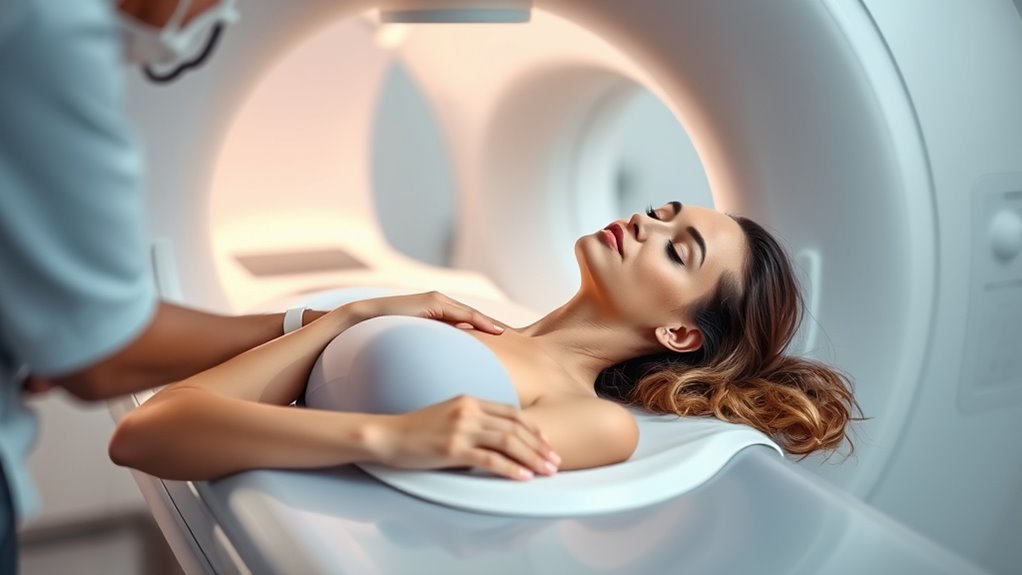Breast cancer screening involves more than just mammograms, which use low-dose X-rays to detect irregularities early. Advances now include 3D imaging and MRI, especially for those at higher risk. Knowing your personal risk factors like genetics or lifestyle can help you and your healthcare provider create a tailored screening plan. Starting early and staying vigilant increases your chances of catching the disease early. Keep exploring to learn more about how these tools can protect your health.
Key Takeaways
- Mammography is the primary screening tool for early breast cancer detection, with new technologies like 3D imaging and MRI enhancing accuracy.
- Genetic testing for mutations such as BRCA1 and BRCA2 helps identify high-risk individuals who may need more frequent or advanced screening.
- Lifestyle modifications, including maintaining a healthy weight and limiting alcohol, can reduce overall breast cancer risk.
- Regular consultations with healthcare providers enable personalized screening plans based on age, risk factors, and family history.
- Emerging tools aim to improve detection rates, reduce false positives, and complement traditional mammography in comprehensive screening strategies.

Have you ever wondered how early detection can save lives? It’s a powerful question, especially when it comes to breast cancer. Advances in screening methods have made it easier for you to catch potential issues early, giving you a better chance of effective treatment. One of the most well-known tools is mammography, which uses low-dose X-rays to detect abnormal breast tissue before any symptoms appear. But screening isn’t just about mammograms; it’s also about understanding your personal risk factors. Genetic testing, for instance, can reveal if you carry specific gene mutations like BRCA1 or BRCA2 that markedly increase your likelihood of developing breast cancer. If genetic testing shows you’re at higher risk, you and your healthcare provider can develop a tailored screening plan that might include more frequent mammograms or other imaging tests. Knowing your genetic makeup empowers you to make informed decisions about your health and take proactive steps to prevent or catch cancer early.
Beyond genetics, lifestyle factors play an essential role in your breast cancer risk. You might not realize it, but habits such as maintaining a healthy weight, staying physically active, limiting alcohol intake, and avoiding tobacco can make a real difference. These factors influence your overall health and can lower your risk of developing breast cancer. Regular screening becomes even more important if you have lifestyle factors that increase your risk. For example, women who are overweight or have a sedentary lifestyle are advised to be more vigilant with their screening schedule. Combining an awareness of your lifestyle factors with genetic testing gives you a thorough picture of your risk profile, helping you make smarter choices about when to start screening and how often to do it. Additionally, understanding the importance of early detection can motivate you to stay consistent with recommended screenings and checkups.
Screening isn’t a one-time event; it’s an ongoing process. Your healthcare provider might recommend beginning mammograms as early as age 40 or earlier if you have strong family histories or genetic predispositions. As research advances, new screening tools and personalized approaches are emerging, expanding beyond traditional mammograms to include 3D imaging and MRI for high-risk individuals. These innovations aim to improve detection rates and reduce false positives. The key is staying informed about your personal risk factors and working closely with your healthcare team to develop a screening plan that’s right for you. Early detection through a combination of mammography, genetic testing, and lifestyle management can markedly improve outcomes. By taking an active role in your health, you increase your chances of catching breast cancer early, when treatment is most effective.
Frequently Asked Questions
How Often Should I Get Mammograms if I Have No Family History?
You should follow general screening guidelines, which recommend getting a mammogram every two years starting at age 50 if you have no family history. However, it’s important to do a risk assessment with your healthcare provider to determine if you need earlier or more frequent screenings. Regular screening helps catch breast cancer early, so stay proactive and discuss your individual risk factors during your checkups.
Are There Risks Associated With False-Positive Mammogram Results?
A false-positive mammogram can be unsettling, and yes, it carries risks like emotional impact and unnecessary follow-up tests. You might feel anxiety or worry about potential cancer, even when it’s not there. While false positives are common, they highlight the importance of discussing concerns with your doctor. Being informed helps you weigh the benefits of screening against these risks, so you stay confident in your health decisions.
What Are the Latest Advancements in Breast Cancer Detection?
You should know that the latest advancements in breast cancer detection include AI diagnostics, which analyze mammograms more accurately and quickly, and genetic testing that identifies risk factors early. These technologies help you catch potential issues sooner, improving treatment outcomes. By combining AI and genetic testing, healthcare providers can personalize screening strategies, making detection more precise and less invasive, ultimately enhancing your chances for effective treatment and peace of mind.
Can Younger Women Benefit From Supplementary Screening Methods?
You might find peace of mind through supplementary screening methods like ultrasound and genetic testing. Younger women, especially those with a family history, can benefit from these options, catching potential concerns early. These tools provide additional reassurance and early detection opportunities that standard mammography might miss. Embracing such proactive measures empowers you to stay vigilant about your health and take control of your future well-being.
How Do Lifestyle Changes Impact Breast Cancer Risk Reduction?
You can reduce your breast cancer risk by making positive lifestyle changes. Adopting a healthy diet modification, like eating more fruits, vegetables, and whole grains, helps lower your risk. Increasing your physical activity, such as regular exercise, also plays a vital role. These habits work together to help maintain a healthy weight and improve overall health, considerably decreasing your chances of developing breast cancer over time.
Conclusion
As you navigate breast cancer screening, remember each test is a lighthouse guiding you through uncertain waters. Mammography acts as a beacon, illuminating hidden threats, while newer methods are like stars revealing the unseen. Embrace these tools as symbols of hope and vigilance, reminding you that awareness is your shield. By trusting your journey and staying informed, you’re wielding a lantern that helps you face the shadows with courage and clarity.








